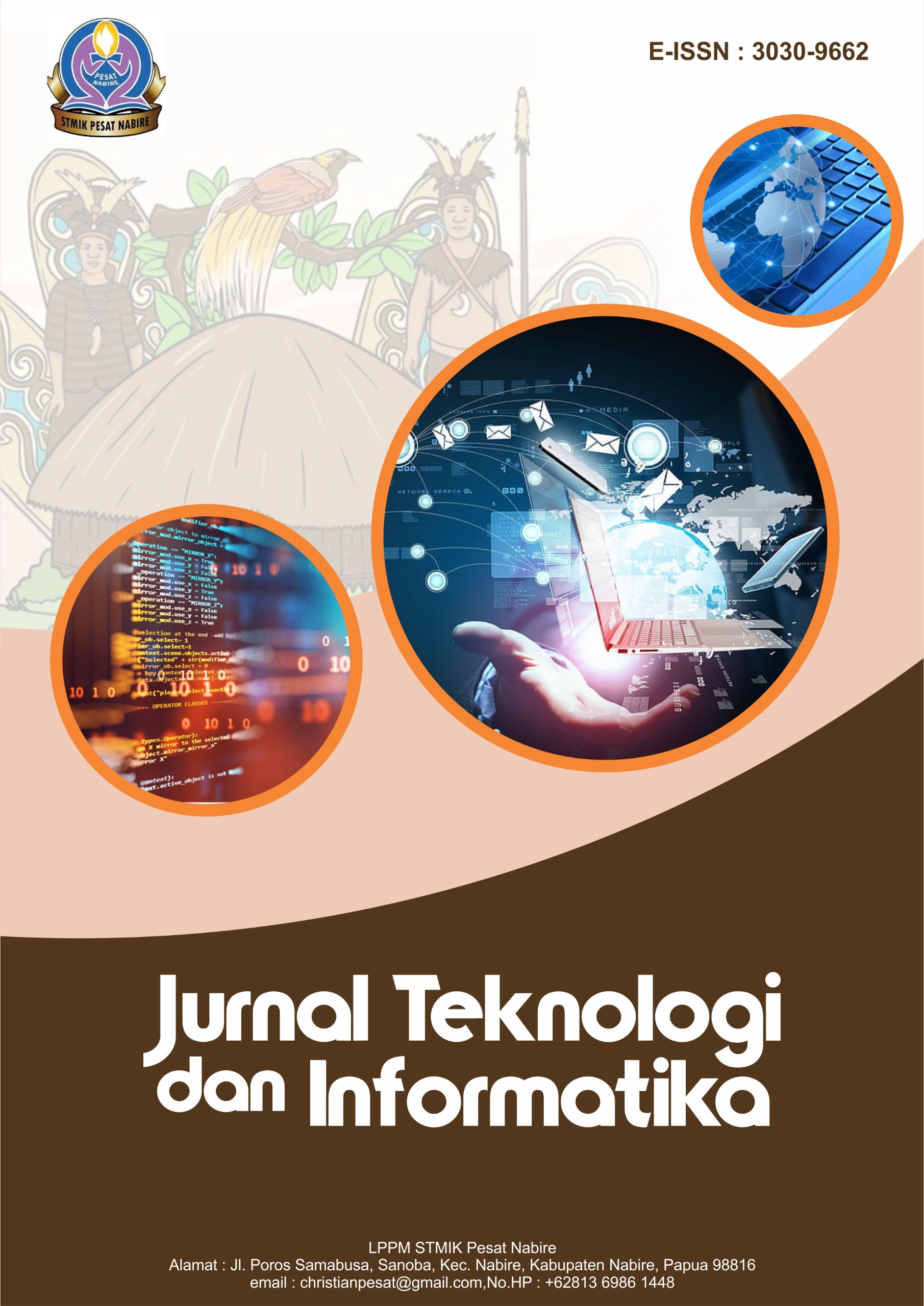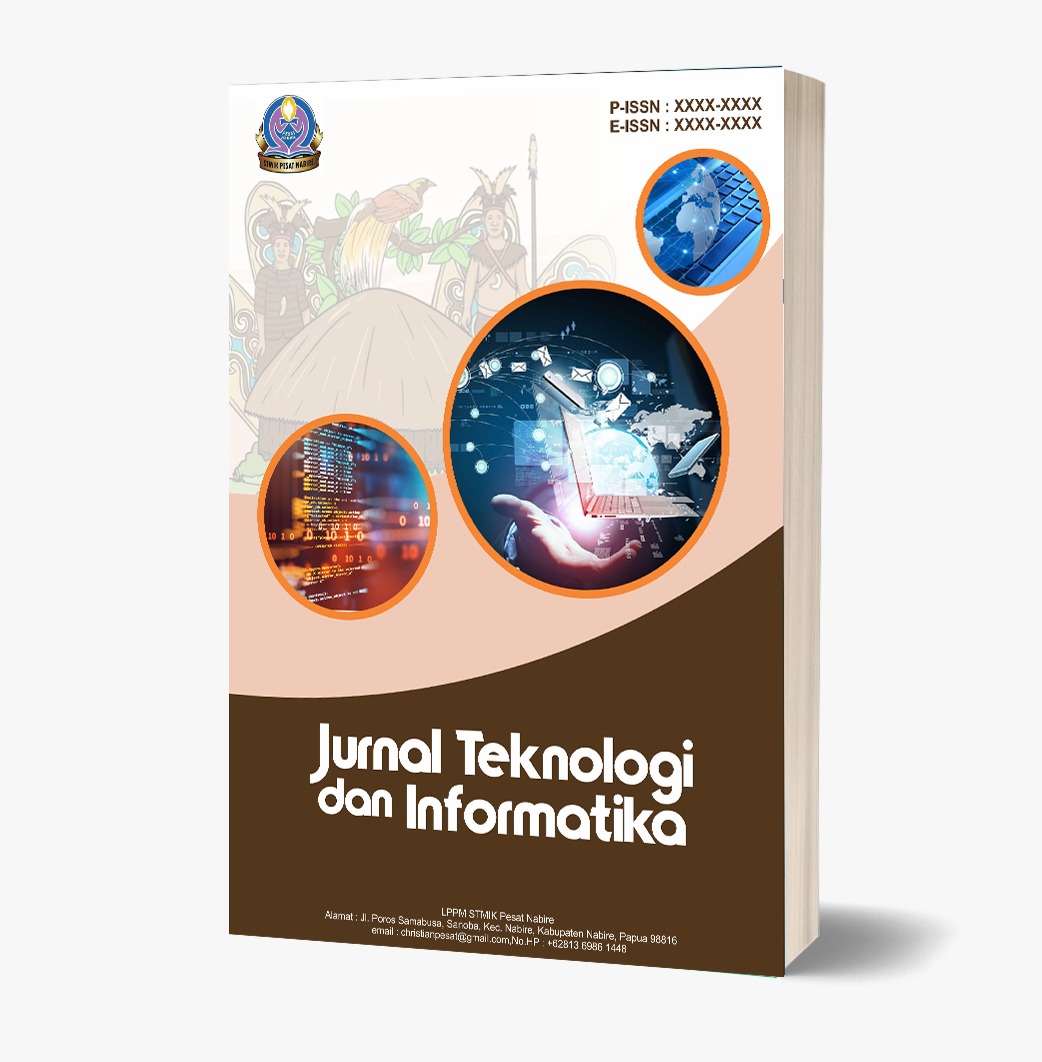Infografis Pemetaan Perkiraan Bahaya Banjir di Kabupaten Waropen Berbasis Sistem Informasi Geografis Menggunakan arcGIS
DOI:
https://doi.org/10.70539/jti.v2i2.41Keywords:
Floods, Geographic Information Systems (GIS), Waropen Regency, Disaster Mitigation, Hydrological ModelingAbstract
Waropen Regency, located in Papua Province, Indonesia, is an area with abundant natural resource potential, such as fisheries (fish, shrimp, crabs), tropical forests and biodiversity. However, the varied topography, high rainfall and geographical conditions make this region vulnerable to flood disasters. This research aims to analyze and predict flood hazards in Waropen Regency using Geographic Information Systems (GIS) such as ArcGIS. The methods used include secondary data collection (topography, rainfall, land use, and river network), data processing using GIS software, as well as spatial analysis using Digital Elevation Models (DEM) and hydrological modeling. The research results produced a flood hazard zoning map that identifies priority areas based on threat level. This map is also used to analyze the potential impact of flooding on settlements, infrastructure and agricultural land. The findings of this research provide important information for local governments and stakeholders in designing disaster risk mitigation strategies, such as building flood control infrastructure and disaster mitigation-based spatial planning. Thus, this research shows the potential of GIS in supporting effective and data-based disaster risk management in Waropen Regency.
References
Environmental Systems Research Institute, “ESRI Shapefile Technical Description,” 1998. [Online]. Available: http://www.esri.com/library/whitepapers/pdfs/shapefile.pdf
N. Alami, E. Riyanto, and L. Ashari, “Analisis Kesiapsiagaan Bencana Banjir Pada Masyarakat,” Surya Beton : Jurnal Ilmu Teknik Sipil, vol. 6, no. 2, pp. 74–79, Oct. 2022, doi: 10.37729/suryabeton.v6i2.2448.
R. Inayati and M. I. Mullah, “Penanggulangan Bencana Banjir di Aceh: Psikologis dan Strategi Efektif,” GALENICAL : Jurnal Kedokteran dan Kesehatan Mahasiswa Malikussaleh, vol. 1, no. 2, p. 97, Aug. 2022, doi: 10.29103/jkkmm.v1i2.17472.
P. Razikin, R. Kumalawati, and D. Arisanty, “Strategi Penangulangan Bencana Banjir Berdasarkan Persepsi Masyarakat Di Kecamatan Barabai Kabupaten Hulu Sungai Tengah,” JPG (Jurnal Pendidikan Geografi), vol. 4, no. 1, pp. 27–39, 2017.
O. Nurdiawan and H. Putri, “Pemetaan Daerah Rawan Banjir Berbasis Sistem Informasi Geografis Sebagai Upaya Antisipasi Bencana Banjir,” Infotech Journal, vol. 4, no. 2, pp. 1–9, 2018, [Online]. Available: https://jurnal.unma.ac.id/index.php/infotech/article/view/837
D. Irwanto, K. Yuliawan, and U. Arfan, “Infografis Prakiraan Cuaca di Provinsi Papua Tengah dengan Menggunakan QGIS & Adobe Photoshop,” Jurnal Teknologi dan Informatika, vol. 1, no. 2, pp. 26–36, 2024, [Online]. Available: https://pesatnabire.id/index.php/jti/article/view/18
D. A. A. Sukma, E. Sudibyo, W. Rahayuningsih, and F. Nugraheni, “Kajian Literatur: Mitigasi Bencana Banjir Berbasis Kearifan Lokal,” Journal Ilmiah Multidisplin, vol. 1, no. Kajian Literatur : Mitigasi Bencana Banjir Berbasis Kearifan Lokal, pp. 257–269, 2024.
Rina Marlina, “Teknik Pengumpulan Data dalam Penelitian Kualitatif Pendidikan,” Jurnal Ilmiah Pendidikan, vol. Volume 12, no. Issue 1, p. Halaman 75-89, 2023.
T. M. A. Mikael Krishna Artanto, Aisyah Nur Shafira, Salsabillah Haya Pratama, “PROSIDING SEMINAR NASIONAL KUSUMA III Kualitas Sumberdaya Manusia Tinjauan Literatur: Analisis Penanggulangan Banjir terhadap Penyakit Diare di Indonesia,” in Prosiding Seminar Nasional Kusuma III, Oktober, 2024, pp. 3062–9365.
BNPB, “Modul Teknis Penyusunan Kajian Risiko Bencana Letusan Gunung Api,” Direktorat Pengurangan Risiko Bencana, 2019.














